The Roller Bearing Conversion
(The whys and wherefors)
by Lorne Goldman, John Sheally II, Peter Mulberry
& Bill Button
June 2005 updated May 2020 updated, May 2022 updated
1. The Whys
2. John H. Sheally II/eMog Pub Version
3. Mulfab Version & Their Fitting Instructions
4. The Morgan Motor Company Version & Caution
5. Wolf Performance Version (my current favourite)
6. Watchpoint for Post-2008 MMC System
7. Watchpoint2 for Earlier Morgans
8. Watchpoint For All Morgans (read first)
9. When All Else Fails
THE WHYS
by LORNE GOLDMAN
As
the stub axles move up the kingpin when the car goes over a bump,
the large kingpin springs compress (obviously) and produce a twisting motion
(not so obviously). All other things being equal, this twisting motion
would be relayed to the spindle and would result in a slight turning of
the wheel. When this occurs and a certain speed, it sets up a harmonic
bounce which can express itself in a violent shimmy.
To avoid this, HFS Morgan placed a bronze plate between
the spring and where its sits on the spindle. The bronze plate then is
held steady (and untwisting) by being bolted to the damper blade which,
in turn,
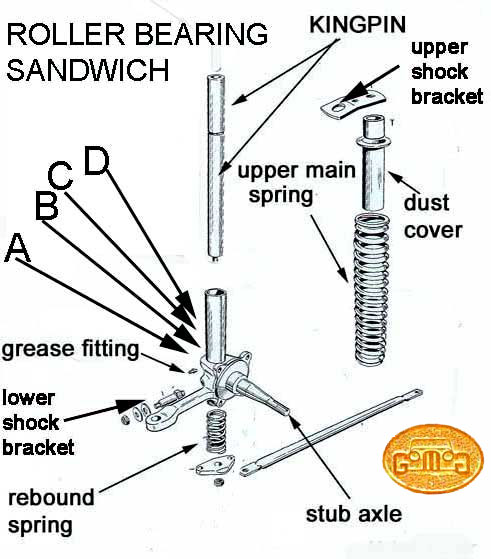 is
held at the frame. With all this, the spring's motion is now transferred
to the immobilized bronze plate rather than the spindle. Of course, since
the spindle moves up and down the damper blade cannot be bolted to the
frame as it must move in and out to follow to the spindle's movement up
and down. Ergo the blades are "sandwiched" into a slot made of small metal
plates and the damper blade shims.
is
held at the frame. With all this, the spring's motion is now transferred
to the immobilized bronze plate rather than the spindle. Of course, since
the spindle moves up and down the damper blade cannot be bolted to the
frame as it must move in and out to follow to the spindle's movement up
and down. Ergo the blades are "sandwiched" into a slot made of small metal
plates and the damper blade shims.
This system has worked for almost 3/4 of a century. Its
drawbacks are the maintenance it requires (as the blades get loose they
allowing twisting to occur at the spindle unless the shims are readjusted
and the blades and shims deteriorate. It handles the twisting movement
in a less efficiently manner than other solutions. The roller bearings
are one of these "other solutions" and a good one.
RESISTANCE
With the standard Morgan setup, the twisting action of
the spring is the twisting action of the spring is dissipated on the bronze
plate (attached to the damper blade). As the bronze plate is, in effect,
fixed, there is some resultant resistance to the twisting on the plate.
In the roller bearing system, the twisting is on the collar
and washer which are seated on the bearings and turn on these..ergo no
resistance and lighter steering.
CLEANING
As the bearings are closed to the elements by the washers
under them and the other washer atop them (with the collar and spring pressure
to hold it all sandwiched, there is nothing that can get in and dirty those
bearings. (Second) ergo, though the area would require normally cleaning,
it would be not susceptible to road dust as it is fully enclosed in the
stainless washers and I would find it hard to see how wear would be a factor.
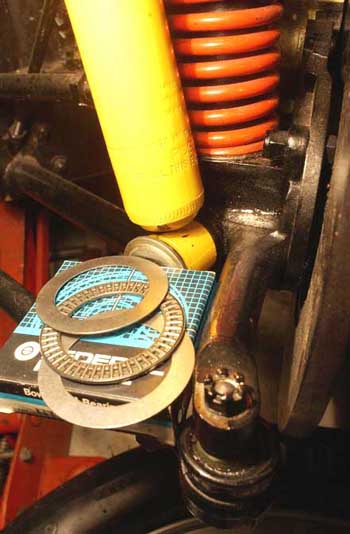 I have attached a diagram the reflects my understanding.
A 4-story sandwich. After removing the kingpin assembly and stub axles,
the bronze plate that attaches to the damper blade is removed from its
position around the stub axle tube (where the kingpins are placed). A washer
is placed on then the thrust roller bearing is pressed fit. Another washer
is placed loose on the bearing ..diagram "C", then the top hat cover is
placed on top of the assembly. The kingpin is re-installed and the large
kingpin spring fits down over the kingpin and sits on the top hat. The
top hat is used to properly position the spring and the sandwich and keep
the grease in the bearing assembly and debris out. The top hat must turn
freely. If it is too tight, use some sandpaper on the inner edge until
it slides loosely.
I have attached a diagram the reflects my understanding.
A 4-story sandwich. After removing the kingpin assembly and stub axles,
the bronze plate that attaches to the damper blade is removed from its
position around the stub axle tube (where the kingpins are placed). A washer
is placed on then the thrust roller bearing is pressed fit. Another washer
is placed loose on the bearing ..diagram "C", then the top hat cover is
placed on top of the assembly. The kingpin is re-installed and the large
kingpin spring fits down over the kingpin and sits on the top hat. The
top hat is used to properly position the spring and the sandwich and keep
the grease in the bearing assembly and debris out. The top hat must turn
freely. If it is too tight, use some sandpaper on the inner edge until
it slides loosely.
JOHN H. SHEALLY II & the eMOG PUB & GRILLE
Here is the "Sheally Setup". It is quite simple. The views included are
of it on John's new Plus 8 Morgan Racer. If you look close under the bottom
of the red main spring you will just see the stainless washers sandwich
with bearing in between.
What you can not see is the machined collar pressed over
the kingpin tube to center the bearing and washers. The collar or collet
is drilled to match the grease fitting hole so that the existing fitting
can be used to grease the bearing from inside to outside serving also to
clean it each time it is greased via gun.
The bearing is a FEDERAL MOGUL/NTA 2840 and the stainless
washers are FEDERAL MOGUL/ TRA 2840 (total of approximately $30US collars
extra). Toss the damper blades and bronze thrust plate and enjoy quick
smooth steering at a small cost with my applied "KISS PRINCIPAL" I have
found that the setup is too simple for a lot of folks to comprehend.
You have to make your own from round steel stock or good
quality steel pipe. It is very simple, you are making a steel "ring" to
press fit over your spindle bushing tube. make the ID tight to press fit
over the tube and press fit all the way down to where your bronze plate
would sit. make the OD to be a snug fit to the ID of your thrust roller
bearing. put the stainless washer over the tube and slide down over the
ring "collar" followed by the bearing and the second washer (lube the bearing
well on both sides) and make sure your grease will feed to the bearing
from your existing (grease nipple/zerk) by drilling a small hole in the
ring and line it up with the oil hole on the spindle. Place your main spring
in place and assemble spindle and kingpin, etc. and enjoy your Morgan.
Sincerely, John H. Sheally II
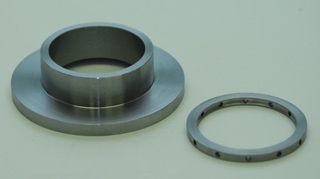
top hat right side up | Kits of the Sheally set up were machined and assembled
through the efforts of Roger Shawyer. Roger had the collar produced and
used a grease ring to spread the grease evenly about the bearing. Care
should taken to ensure that the collar freely turns about the tube. These
assemblies, made as an eMog Pub
initiative, are no longer available. However, they can be reproduced
by a machine shop to order along with the other parts are listed above.. |
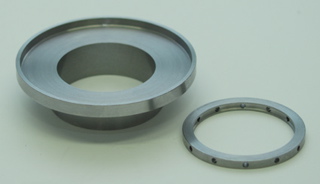
top hat upside down
|
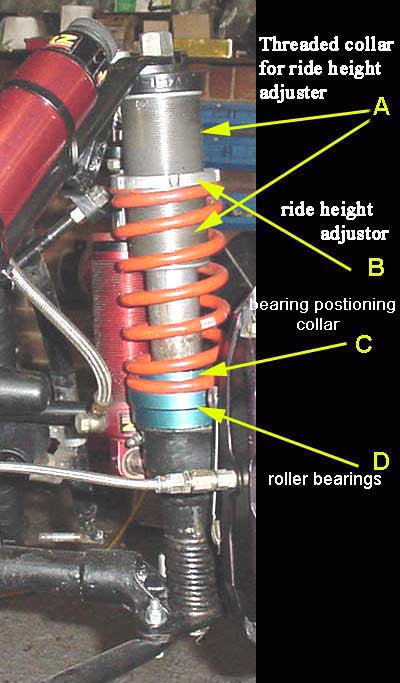
PETER MULBERRY
Peter Mulberry extends the thrust roller bearing principle ..using
different ball bearings within a housing as can be seen by the picture.
As well, the main spring is changed. For racers, there is an interesting
adaptation (shown in the picture) of a treaded collar at the top with an
adjuster. This 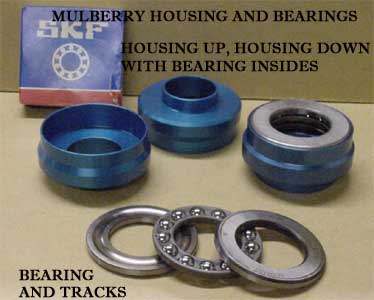 allows the ride height to be changed quickly and conveniently.
allows the ride height to be changed quickly and conveniently.
Peter adds a worthwhile note on the reasons for vibration
AFTER this mod.
"Probably the most likely cause of wheel wobble when fitting
roller bearings is removing the damper blade. Strange to believe but every
Morgan is different, some will 'wobble', some not at all. Why could
that be? What use is fitting rollers when the Mog is going to shake her
head along the road?
The advantages have been commented several times, lighter
steering, smoother action, disadvantages as far as I believe are capital
outlay to buy the bits and getting your hands dirty to fit said parts.
So this still does not answer the problem of wheel wobble. So why take
away the damper blade?
Trying not to get too technical, the blade fulfills two
functions. Without the bronze thrust pad the road spring would sit directly
upon the stub axle. When the steering was turned the spring would turn
as well, but the top of the spring is hard against the top of the crosshead
which does not want to turn so the end result is akin to winding up a large
spring in one direction and unwinding in the other. Very strange. So we
have the bronze thrust pad between the spring and stub axle which stops
the spring winding up. The second function is a friction damper to give
it its correct name. Two key words here, first was friction, hard work
and effort, roller bearings take all that away, second word was damper.
It is damping the oscillation that is wheel wobble.
If
you still have the dreaded wheel wobble after the bearing installation,
look to your castor angle. A few will be conversant with the term, but
basically it is the angle that the kingpin leans backward as you look at
your car from the side. It is what gives your steering its self-centering
effect. Too little and no self-center, too much and grossly heavy steering.
Everybody
must have pushed a shopping cart sometime. Ever
had one that the wheels do their own war dance? The factory
measurement
for castor is 4 degrees, give or take a bit for allowance. If yours is
a bit less you have lost the self-centering ability and gained wheel
wobble,
if you have a bit more than 4 degrees you have one of those delightful
drivers that track straight and true with hands off the wheel. I always
set mine up at six degrees and have no problems at all. Unfortunately
the
factory have made it all non adjustable. But it can be tweaked if you
know
what to do. If you are not sure where yours is visit an auto align
center
and they will give you a read out of your front suspension. Then you
know. I use these..two Morgans, 170,000 miles, no problems in 24
years.
 WATCHPOINT2 FOR EARLIER CARS (posted 2006): Within
the eMog community, many (100s) performed this modification.
Overwhelmingly, they were successful and without
issue. However, we DID find that earlier cars were far more
susceptible to
the dreaded Malvern Dance, akja an uncontrollable wobble at the front
end that appears at the vibration point of the wheels/tyres they use.
There was speculation that the thinner tyres
and less castor (the modern
era began with 4 degrees) or some other element of earlier front end
geometry made those cars more vulnerable than later cars. One
of the
best home Morgan mechanics I know, the well-respected Bob Nogueira,
found this to be the case with his 1960s Plus 4. I wish I had time to
solve this quandary, but I allocate my time according to the
number of owners effected. What is posted in the Manual is merely 25%
of what I have in archives. Of course, I am always willing to
help if you contact me directly. WATCHPOINT2 FOR EARLIER CARS (posted 2006): Within
the eMog community, many (100s) performed this modification.
Overwhelmingly, they were successful and without
issue. However, we DID find that earlier cars were far more
susceptible to
the dreaded Malvern Dance, akja an uncontrollable wobble at the front
end that appears at the vibration point of the wheels/tyres they use.
There was speculation that the thinner tyres
and less castor (the modern
era began with 4 degrees) or some other element of earlier front end
geometry made those cars more vulnerable than later cars. One
of the
best home Morgan mechanics I know, the well-respected Bob Nogueira,
found this to be the case with his 1960s Plus 4. I wish I had time to
solve this quandary, but I allocate my time according to the
number of owners effected. What is posted in the Manual is merely 25%
of what I have in archives. Of course, I am always willing to
help if you contact me directly.
Bob found that he could eliminate the sad effect by re-installing the damper blades along with the damper blade system.
Damper Blades seem to some (not all) earlier trads as
a method
for divorcing the influences of the road from the main spring while
steering bearing/races, which should accomplish the same divorce
theoretically ease steering and limit the need for maintenance and
blade fiddling. Using the combination should cause
no prejudice harm whatsoever (though it adds back the original
hassles). Damper blade plates (the thick bronze plates the blades
attach to at the stub axle) do not add sufficient height to
pre-load (aka unduly stiffen) the main springs as the Mulberry and Factory bearing/races might do without compensation in main spring height.
(I installed shortened Main Springs with my Mulberry bearing system/ These can
be had at any spring rate you might want
to try merely shortened in length.) I favor the traditional Plus 4 spring rate on my muscly Plus 8 (140). They were marked by the Works with a "Morgan Plus 4" script (to the right)
|
THE MORGAN MOTOR COMPANY (PostScript in 2009) (another in 2020)
The bearing systems do make the cars much easier
to steer but also more likely to vibrate and wobble if all is not as it
should be. When anomalies (ie.vibration) were experienced with older Morgans
(pre-1968) we were forced to examine more closely and found and corrected
other problems, after which all was well.
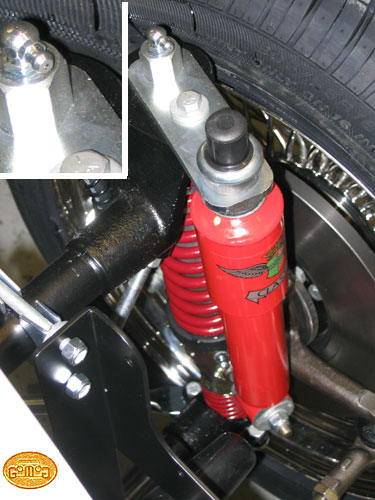 If
wobble/vibration is experienced by later cars (post 1980), it normally
indicates a damaged, very poorly set up or poorly maintained front end
which should
If
wobble/vibration is experienced by later cars (post 1980), it normally
indicates a damaged, very poorly set up or poorly maintained front end
which should 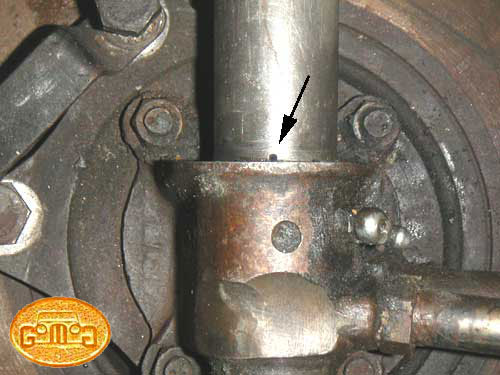 be brought to the attention of your mechanic. In such cases,
if this seems too much of a hassle, you can rebuild your front again with
the damper blades, with or without the bearings. We do not recommend you
increasing your castor without resort to an expert who has done so before.
When
all else fails you can try the Mercedes damper.
be brought to the attention of your mechanic. In such cases,
if this seems too much of a hassle, you can rebuild your front again with
the damper blades, with or without the bearings. We do not recommend you
increasing your castor without resort to an expert who has done so before.
When
all else fails you can try the Mercedes damper.
After
this article was posted, the Morgan Motor Company copied the system designed by Peter
Mulberry. Like the Mulberry
system, the height of the bearing assembly requires the use of shorter
main springs. (Be careful which spring rate you get!). After a period without,
the Company began using drilled kingpins with grease nipples. This is
NOT the one shot oiler system that was happily removed some years ago.
The new passage is not for oil, but rather made larger for grease and is
drilled further down to feed the steering bearing assembly which, unlike
the other systems described above, it seems the Factory did not pre-pack their assemblies with grease on installation.
WATCHPOINT FOR POST 2008 CARS
From
the eMog Pub in January 2004 and updated January 2011 and in June 2020.All these bearing assemblies NEED grease. This was provided,
in pre-2008 cars with retrofits, by the little grease exit hole the MMC used to drill
at the junction of the stub axle shelf and the stub axle tube. (see
image) For these
bearing assemblies, this exit was perfect as it
comes up under the housing at a place where it flows easily into the
whole
assembly and the bearings. After a short delay, the MMC drilled three
holes in the stub axle tube to feed their bearing assemblies.
However, ever more frequently, when owners DO open up this area, it is found that the MMC bearing assemblies are bereft of grease, dry, with signs of rust and often seized. This results in the opposite effect that these systems are supposed to address. Rather
than easing steering, these bearings make steering harder and can
have other sad expressions...they must be addressed. Why did this
happen. A number of our favourite gurus have added their speculations
to my own below. Any of these or a combination of them could be causing the problem.
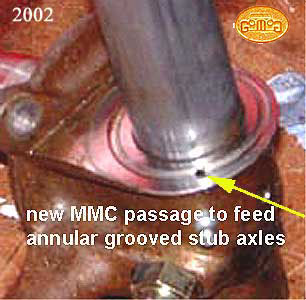 1. It seems the Factory does not pre-pack their assemblies with grease on installation. It
has long been thought that with an exclosed system, pressured closed by
the immense force of the compressed mainspring, that once packed, these
bearing assemblies would NEVER lose any grease. That has been the case
when I have had the occasion to disassemble my Mulfab front
end.
1. It seems the Factory does not pre-pack their assemblies with grease on installation. It
has long been thought that with an exclosed system, pressured closed by
the immense force of the compressed mainspring, that once packed, these
bearing assemblies would NEVER lose any grease. That has been the case
when I have had the occasion to disassemble my Mulfab front
end.
2. On disassembly, we have discovered that the seal the MMC uses, has a hole in it.
3.
Owners are, as a rule, pretty timid front end greasers. Improper
greasing is rampant, even among those who are concientous about
it. The grease gun becomes dislodged, or they give up far too
prematurely rather than waiting until they see the grease coming out
the right place.
Any of these things might be causing the evidence we are seeing..but regardless of the cause, IT MUST BE ADDRESSED.
WOLF PERFORMANCE June 2020
Wolf
Performance (aka Cain Poulton) is a relatively new entry into steering
bearings sweepstakes. Cain has come up with two versions, one based on
roller bearings and the other on thrust bearings. Frankly, both
have advantages..it is a matter of which of their charcteristics you
favour. No complaints or feedback has yet to be heard.
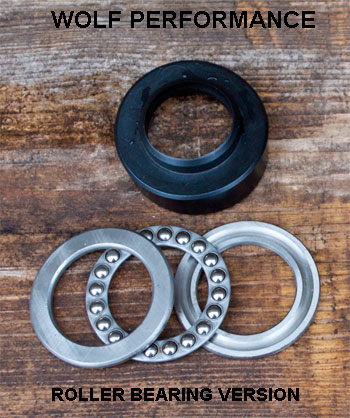 | I am
always pleased to see new and honest suppliers enter the Morgan
community. Too many old stalwarts have retired or moved on to other
things since the Company began purloining their ideas outright
rather than encouraging their ingenuity as Peter Morgan did for
decades. :( As well, in the last 15 years there has been much super
expensive silliness promoted, discouraging owner learning and ideas as
well, prejudicing the cars and culminating in the lack of real
development of the trad for the last two decades, a factor in its
recent demise. | 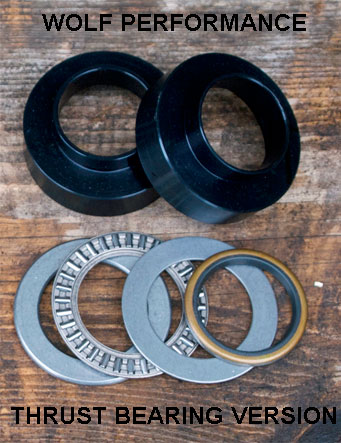 |
I am now giving THESE bearings my highest recommendation for this genre of components. It
is not merely their price, it is the quality of their manufacture and
design. As well, with their lower height, they can be swapped in
without requiring shortened main springs.
Rebound Spring Length Watchpoint: In
each of these cases, when retro-fitting thse bearings, one compresses
the springs by the height of the height of the top hat cover of the
bearing. The amount of this compression varies from system to system,
negligibly with the Sheally method above and the most with the Mulberry system,
which is undoubtely the strongest and the most widely used before the
MMC copied the system into its stock cars. The other systems compress
the springs somewhere between Shally and Mulberry methods. Proper Plus
8 springs have 140s or 140lbs per inch
but these were changed to a lower rate (along with the Morgan Plus 4s
and Roadsters) which is why they feel "wallowly" to cogniescenti and
steering precision appreciaters. Dealers, racers and agressive drivers in-the-know swap them out on arrival.
Rebound springs and the rebound section here in section 8,
are already too long, and all have spring rates double that of the Main
Springs. That means that the top hat flange compresses the springs and
extra, for example,1/2 Inch or adds another 60 pounds of pressure if
the same length spinrgs are used. Along with the rebound problem from
the Factory, this will prejudice handling and comfort even more. Astute
installers will notice that they must compress the Main Spring more to
re-install the stub axle or that the bolt on top must be longer. What
they are do is make the front end stiffer when their goal was to
make their steering easier. Sadly, some of the suppliers who copied Peter Mulberry, mention nothing
to their buyers. Peter Mulberry used to receommnded buying the same
Main Springs but shorter ones or to cut the existing main springs down.
That is what I did for all my Morgans.
|
BACK
 is
held at the frame. With all this, the spring's motion is now transferred
to the immobilized bronze plate rather than the spindle. Of course, since
the spindle moves up and down the damper blade cannot be bolted to the
frame as it must move in and out to follow to the spindle's movement up
and down. Ergo the blades are "sandwiched" into a slot made of small metal
plates and the damper blade shims.
is
held at the frame. With all this, the spring's motion is now transferred
to the immobilized bronze plate rather than the spindle. Of course, since
the spindle moves up and down the damper blade cannot be bolted to the
frame as it must move in and out to follow to the spindle's movement up
and down. Ergo the blades are "sandwiched" into a slot made of small metal
plates and the damper blade shims.
 I have attached a diagram the reflects my understanding.
A 4-story sandwich. After removing the kingpin assembly and stub axles,
the bronze plate that attaches to the damper blade is removed from its
position around the stub axle tube (where the kingpins are placed). A washer
is placed on then the thrust roller bearing is pressed fit. Another washer
is placed loose on the bearing ..diagram "C", then the top hat cover is
placed on top of the assembly. The kingpin is re-installed and the large
kingpin spring fits down over the kingpin and sits on the top hat. The
top hat is used to properly position the spring and the sandwich and keep
the grease in the bearing assembly and debris out. The top hat must turn
freely. If it is too tight, use some sandpaper on the inner edge until
it slides loosely.
I have attached a diagram the reflects my understanding.
A 4-story sandwich. After removing the kingpin assembly and stub axles,
the bronze plate that attaches to the damper blade is removed from its
position around the stub axle tube (where the kingpins are placed). A washer
is placed on then the thrust roller bearing is pressed fit. Another washer
is placed loose on the bearing ..diagram "C", then the top hat cover is
placed on top of the assembly. The kingpin is re-installed and the large
kingpin spring fits down over the kingpin and sits on the top hat. The
top hat is used to properly position the spring and the sandwich and keep
the grease in the bearing assembly and debris out. The top hat must turn
freely. If it is too tight, use some sandpaper on the inner edge until
it slides loosely.


 allows the ride height to be changed quickly and conveniently.
allows the ride height to be changed quickly and conveniently.
 WATCHPOINT2 FOR EARLIER CARS (posted 2006):
WATCHPOINT2 FOR EARLIER CARS (posted 2006): If
wobble/vibration is experienced by later cars (post 1980), it normally
indicates a damaged, very poorly set up or poorly maintained front end
which should
If
wobble/vibration is experienced by later cars (post 1980), it normally
indicates a damaged, very poorly set up or poorly maintained front end
which should  be brought to the attention of your mechanic. In such cases,
if this seems too much of a hassle, you can rebuild your front again with
the damper blades, with or without the bearings. We do not recommend you
increasing your castor without resort to an expert who has done so before.
be brought to the attention of your mechanic. In such cases,
if this seems too much of a hassle, you can rebuild your front again with
the damper blades, with or without the bearings. We do not recommend you
increasing your castor without resort to an expert who has done so before.


